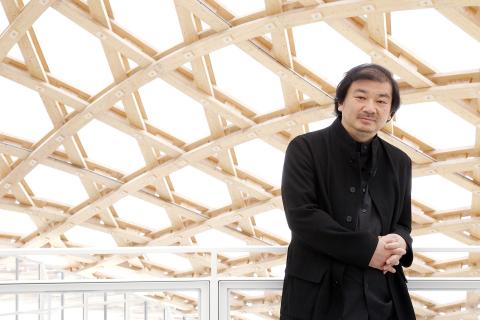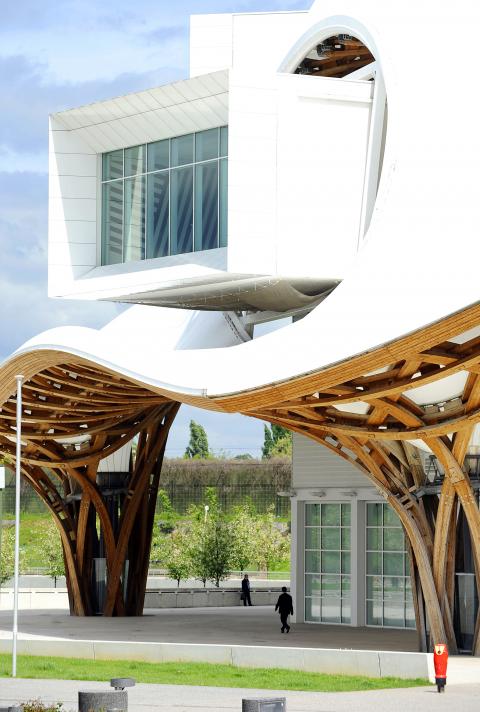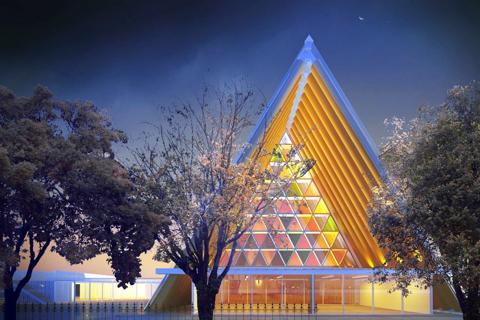Architecture generally involves creating monuments to permanence from substantial materials like steel and concrete. Yet this year, the discipline’s top award is going to a man who is best known for making temporary housing out of transient materials like paper tubes and plastic beer crates.
On Monday, Japanese architect Shigeru Ban was named the winner of this year’s Pritzker Architecture Prize, largely because of his work designing shelters after natural disasters in places like Rwanda, Turkey, India, China, Haiti and Japan.
“His buildings provide shelter, community centers and spiritual places for those who have suffered tremendous loss and destruction,” the jury said in its citation. “When tragedy strikes, he is often there from the beginning.”

Photo: REUTERS
In a telephone interview from Paris, Ban, 56, said he was honored to have won, not because the Pritzker would raise his profile but because it affirms the humanitarian emphasis of his work.
“I’m trying to understand the meaning of this encouragement,” he said of the prize.
“It’s not the award for achievement. I have not made a great achievement.”

Photos: AFP
The prize, established in 1979 and viewed as the Nobel of architecture awards, suggests otherwise.
Ban is credited with challenging traditional notions of domestic space and what it means to have a roof over your head. His Naked House in Saitama, Japan, features four rooms on casters within a house clad in clear corrugated plastic and surrounded by rice fields.
He stepped in after the 19th-century Christchurch Cathedral in New Zealand was ravaged by a 2011 earthquake, designing a transitional sanctuary fashioned mainly from cardboard tubes.

Photo: AFP
Asked to create something related to the Pont du Gard, a Roman aqueduct on the Gardon River in the south of France, he came up with a footbridge, using his signature cardboard tubes and recycled paper as a counterpoint to the ancient structure’s heavy stone. And his Curtain Wall House in Tokyo links interior and exterior with white curtains that can be opened and closed.
“His works are airy, curvaceous, balletic,” Michael Kimmelman wrote in The New York Times in 2007. “An heir to Buckminster Fuller and Oscar Niemeyer, to Japanese traditional architecture and to Alvar Aalto, he is an old-school modernist with a poet’s touch and an engineer’s inventiveness.”
Ban is also known for somewhat more conventional projects, like the Pompidou Center’s satellite museum in Metz, France (with a roof inspired by a woven bamboo hat) and his entry for the competition to redesign the World Trade Center as part of a team that included Rafael Vinoly, Frederic Schwartz and Ken Smith. Ban’s Aspen Art Museum, a 33,000-square-foot structure in Colorado with a woven exterior wood screen, is to open in August.
Yet, in a way, Ban also represents a kind of anti-architecture, a rejection of the aura of celebrity status pursued by many in the profession. In public remarks this month, for example, Ban took architects to task for not putting their expertise to work for a greater social good.
“I’m not saying I’m against building monuments, but I’m thinking we can work more for the public,” he said in London at Ecobuild, an annual conference on sustainable design. “Architects are not building temporary housing because we are too busy building for the privileged people.”
Each year the Pritzker goes to a living architect whose work has contributed to humanity and the built environment. Ban will receive a US$100,000 grant and a bronze medallion to be awarded on June 13 in a ceremony at the Rijksmuseum in Amsterdam.
Previous winners of the prize have included Philip Johnson, Frank Gehry, Zaha Hadid and Norman Foster.
Ban was originally drawn to disaster relief by the squalid condition of Rwanda’s refugee camps in 1994. “I thought we could improve them,” he said. He traveled to Geneva to work with the UN High Commissioner for Refugees on designing prototype tents with paper poles. He then turned his attention to the aftermath of the 1995 earthquake in Kobe, Japan, designing emergency housing with beer-crate foundations and paper-tube walls.
He has since become a familiar presence on the scene of major international disasters, arriving with architecture students to teach them about developing solutions at such sites.
Many of Ban’s temporary structures have become semipermanent. In Kobe, for example, shelters meant to be used for three years were used for 10.
“Whether they keep it is up to them,” he said.
Born in Tokyo in 1957, Ban studied at the Southern California Institute of Architecture before transferring to the Cooper Union School of Architecture in New York, where he earned his bachelor’s degree in architecture in 1984. A year later, Ban established a private practice in Tokyo; he now also has offices in Paris and New York.
Many New Yorkers became acquainted with his work with the arrival of his Nomadic Museum, mobile shipping containers parked on a Hudson River pier to showcase Ashes and Snow, a 2005 exhibition of Gregory Colbert’s animal photography that made its debut in Venice.
With Dean Maltz, the architect who runs the US branch of his practice, Ban has also designed a set of glass duplex penthouses atop the Cast Iron House, a 132-year-old landmark on lower Broadway, and Metal Shutter Houses, a condominium in Chelsea. And Ban designed Camper’s flagship shoe store with red-and-white interiors and a vertical garden.
Although such commissions are highly lucrative, Ban said he is not motivated by the compensation.
“I’m not really interested in making money,” he said. “I’m not interested in the design fee.”
“As long as I can make people happy to use my building,” he added, “I’m happy.”

Even by the standards of Ukraine’s International Legion, which comprises volunteers from over 55 countries, Han has an unusual backstory. Born in Taichung, he grew up in Costa Rica — then one of Taiwan’s diplomatic allies — where a relative worked for the embassy. After attending an American international high school in San Jose, Costa Rica’s capital, Han — who prefers to use only his given name for OPSEC (operations security) reasons — moved to the US in his teens. He attended Penn State University before returning to Taiwan to work in the semiconductor industry in Kaohsiung, where he

On May 2, Chinese Nationalist Party (KMT) Chairman Eric Chu (朱立倫), at a meeting in support of Taipei city councilors at party headquarters, compared President William Lai (賴清德) to Hitler. Chu claimed that unlike any other democracy worldwide in history, no other leader was rooting out opposing parties like Lai and the Democratic Progressive Party (DPP). That his statements are wildly inaccurate was not the point. It was a rallying cry, not a history lesson. This was intentional to provoke the international diplomatic community into a response, which was promptly provided. Both the German and Israeli offices issued statements on Facebook

May 18 to May 24 Pastor Yang Hsu’s (楊煦) congregation was shocked upon seeing the land he chose to build his orphanage. It was surrounded by mountains on three sides, and the only way to access it was to cross a river by foot. The soil was poor due to runoff, and large rocks strewn across the plot prevented much from growing. In addition, there was no running water or electricity. But it was all Yang could afford. He and his Indigenous Atayal wife Lin Feng-ying (林鳳英) had already been caring for 24 orphans in their home, and they were in

Australia’s ABC last week published a piece on the recall campaign. The article emphasized the divisions in Taiwanese society and blamed the recall for worsening them. It quotes a supporter of the Taiwan People’s Party (TPP) as saying “I’m 43 years old, born and raised here, and I’ve never seen the country this divided in my entire life.” Apparently, as an adult, she slept through the post-election violence in 2000 and 2004 by the Chinese Nationalist Party (KMT), the veiled coup threats by the military when Chen Shui-bian (陳水扁) became president, the 2006 Red Shirt protests against him ginned up by